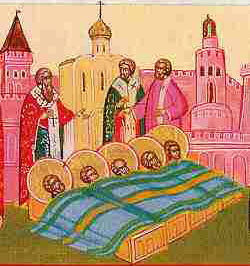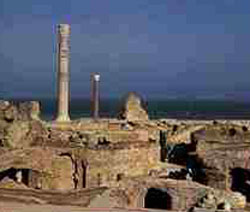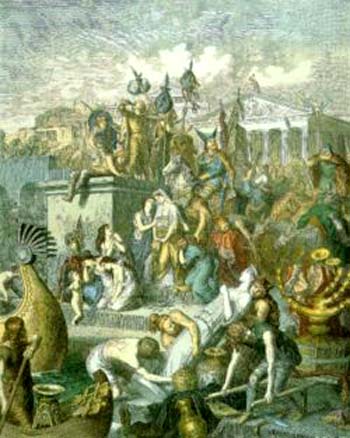 |
The Saint of the Day
St. Eugenius of Carthage, July 13
Prof. Plinio Corrêa de Oliveira
Biographical selection:
In 428 Genseric, the King of the Vandals, invaded and took over North Africa. The Vandals, who were Arians, had the practice of persecuting the Catholics, especially the Bishops. They plundered and destroyed Carthage's churches and monasteries, and burned alive two Bishops. They banished to the desert St. Quodvultdeus, the city's Bishop, along with other Prelates and clergy as well as 5,000 lay people.
As they left, mothers followed the ecclesiastics, weeping and crying: "Who will take care of us after you leave? Who will baptize our children, hear our confessions and reconcile us with God? Who will bury us when we die? Who will offer the Divine Sacrifice? Let us go with you."
Except for the brief episcopate of St. Deogratias, the see of Carthage had been vacant for 50 years. In 481, Huneric, who succeeded Genseric, permitted the Catholics to choose a Bishop. The saintly and well-loved Eugenius was unanimously chosen. Influenced by the Arian bishops, however, Huneric imposed draconian conditions on the Catholics, among others, that no Vandal could convert. St. Eugenius did not accept these terms, and a new persecution began, especially against the Vandals who had embraced the Catholic Faith.

St. Eugenius buried many martyrs who died rather than renounce the Catholic Faith and become Arians.
|
There were sublime episodes in the many martyrdoms that took place when St. Eugenius was Bishop. A woman, for example, was brought to watch her son cruelly tortured for being a Catholic. Seeing him tremble in face of the torment, without hesitation she addressed him thus: "My son, remember that we were baptized in the name of the Trinity in the bosom of the Holy Church, our Mother." Hearing this, the youth courageously faced martyrdom.
Many of the Catholics who apostatized from fear of martyrdom became cruel persecutors of their faithful brothers. This is the famous case of Elpidophorus who was appointed judge at Carthage. One day Deacon Muritta, who had baptized Elpidophorus when he was a child, was brought before him. With him Muritta brought the chrismale, or white garment, with which he had clothed the child after he was baptized. Showing it to the whole assembly, he said to the apostate judge: "This garment will accuse you when God the Judge shall appear in majesty on the last day. It will bear testimony against you to your condemnation. This garment that covered you when, pure and unspotted, you left the waters of Baptism, will increase your torment when you will be engulfed by the eternal flames." St. Muritta is mentioned together with St. Eugenius in the Roman Martyrology on July 13.
Thrasimund, another Arian, was called to the throne in 496. At times he persecuted the Catholics, and other times he showed moderation. Eventually he condemned St. Eugenius to death, and then changed the sentence and banished him to Languedoc (France). St. Eugenius died in exile in 505, in a monastery that he founded.
Comments of Prof. Plinio:
This is a rich selection that allows me to make several observations.
First, at that time North Africa was united under Roman dominion and was famous for its great agricultural progress. It was a highly civilized area. The Vandals destroyed almost everything of this civilization and left the area in desolation. Nothing is comparable to the savage devastation the Vandals carried out there, which was characterized by a special ferocity, brutality, and senselessness in destroying objects of art and monuments. It is because of this that the terms Vandal and vandalism became synonymous, referring to this kind of uncivilized destruction.
Second, I don't know if you realize what it was to be exiled to the desert. It was a place lacking sufficient conditions for life, so the people banished there either died or lived a miserable existence without defense among the wild beasts in the terrible climate. Five thousand people were condemned to that life.

Ruins of ancient Carthage
|
Now, I ask you to please consider if the Inquisition would have exiled these people to die in the desert. It would be universally condemned and constantly spoken of in our revolutionary world. But the Inquisition did not do such a thing. It only condemned a few heretics, and because of this every revolutionary around the world talks about the supposed fanaticism of the Inquisition.
Who says a word against the real fanaticism of the Arian heretics who sent 5,000 people to the desert? Old and weak people, children and women, sent there to die? No one says anything, no one protests. Why? Because today most of the people are revolutionaries and they share the same bad faith and prejudices of the Revolution against everything that is Catholic.
Third, the scene where the people grieved at seeing the Bishops and ecclesiastics leaving for the desert shows how the normal reaction of the faithful is to follow their true pastors. The reason we do not have scenes like this anymore is because today's enemies of the Church avoid persecutions. The promoters of Communism, for instance, prefer to "dialogue" with a Bishop because this will not cause a reaction in the grassroots, which instead becomes open to the enemy's influence. It is a more subtle method of destroying the Faith and one with a greater malice.
Fourth, the magnificent episode of the mother who encouraged her son to die a martyr in defense of the Catholic Faith is also worthy of comment. If, for example, this lady had been a Roman matron who had so counseled her son to face death, not in defense of the Catholic Faith, but for Rome, she would be a celebrity. Everyone would say: "What a great thing she did! What heroism! How grandiose was Rome that produced a woman like her!" If her name were Cornelia, commemorating her valor there would be Cornelia Squares and Avenues everywhere, a city called Corneliapolis, an ode to Cornelia, a hymn to Cornelia, etc. But since her words were not spoken in honor of Rome, but for an incomparably higher reason, which is the love of Our Lord Jesus Christ and the Catholic Faith, this sublime fact has been put aside and forgotten. Almost no one knows it.

Vandals pillaged and destroyed civilization in North Africa
|
Nonetheless, it is difficult to find a greater example of grace overcoming nature than this episode. Every mother thinks of her son. When her son's life is threatened, her first concern is to save him. Her normal response would be to go and plead before the judge: "Please, kill me, but spare the life of my son." This lady at the time of St. Eugenius overcame all her natural sentiments and encouraged her son to die well for the Catholic Faith. She used her maternal authority and influence to lead him in the right direction, to final perseverance. This mother should be the example set before so many other mothers, who instead of taking this noble position, try to deviate their sons from their vocations only to keep them closer to themselves.
Fifth, another extraordinary action was carried out by St. Muritta, the one who challenged the apostate judge by showing him his baptismal robe and threatening him with eternal fire. He said: "I bring you the white robe that covered you when you became a son of God, when your soul was a temple of the Holy Ghost. Now measure how far you have gone in a different direction since then and convert, because Hell is opening beneath your feet." He said this in front of the assembly of people, which added a note of greater ignominy to the action of the judge.
Someone might object and say that these are very harsh words. I would answer: "It is the same language Our Lady used when she showed Hell to the three children of Fatima. And I don't think that Our Lady uses harsh language. She spoke as she did to do a good for the children and for all of us who hear about it." St. Muritta also said what he said to try to save the judge. He had the obligation to do so because it might have caused his conversion. Saying these things, he further jeopardized his own situation and risked receiving a more severe sentence and greater torments in his martyrdom. He did not hesitate, he accepted the risk for the good of his enemy. It was an intelligent act of generous charity. His target was to save the soul of the one he was insulting.
St. Eugenius, about whom the selection speaks very little, was the Bishop over all these martyrs and, as such, became the symbol of all of them. He was set by the Church as a precious stone in a diadem made of the gold of many martyrs. He inspired and comforted them. He died far from his country in exile after great suffering. Here you have the figure of St. Eugenius, the splendorous head of his flock, which he led to Heaven, like the good shepherd that he was.
Let us ask him to give us good shepherds, and also to help us, with or without good shepherds, be as faithful as we should to the Holy Roman Catholic and Apostolic Church, our divine and most beloved Mother.


  | | Prof. Plinio Corrêa de Oliveira | |
The Saint of the Day features highlights from the lives of saints based on comments made by the late Prof. Plinio Corrêa de Oliveira. Following the example of St. John Bosco who used to make similar talks for the boys of his College, each evening it was Prof. Plinio's custom to make a short commentary on the lives of the next day's saint in a meeting for youth in order to encourage them in the practice of virtue and love for the Catholic Church. TIA thought that its readers could profit from these valuable commentaries.
The texts of both the biographical data and the comments come from personal notes taken by Atila S. Guimarães from 1964 to 1995. Given the fact that the source is a personal notebook, it is possible that at times the biographic notes transcribed here will not rigorously follow the original text read by Prof. Plinio. The commentaries have also been adapted and translated for TIA's site.
|
Saint of the Day | Home | Books | CDs | Search | Contact Us | Donate

© 2002- Tradition in Action, Inc. All Rights Reserved
|
 |

|